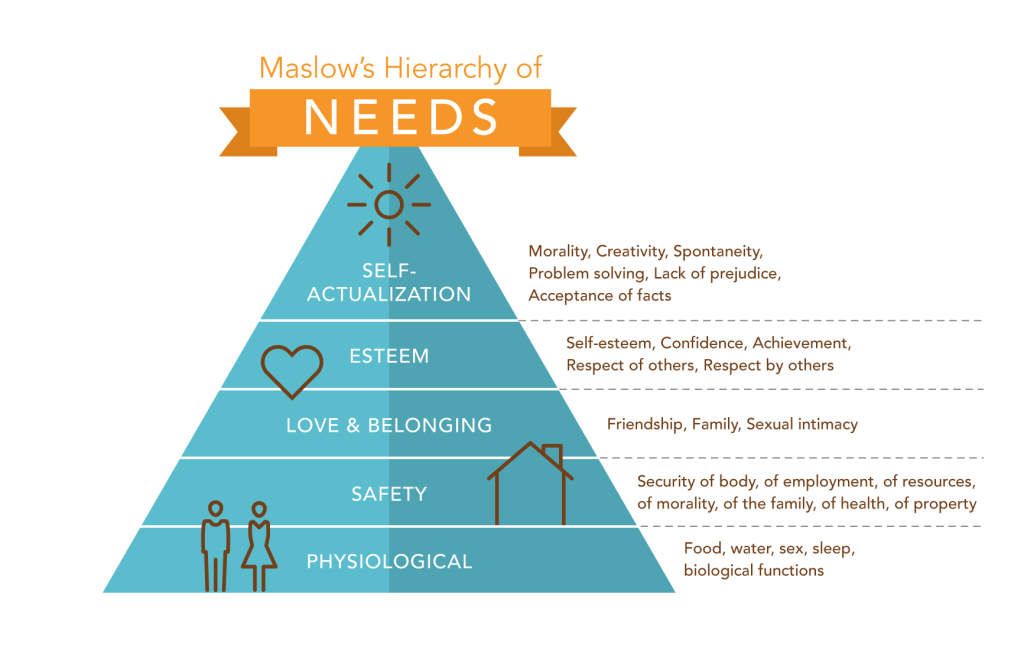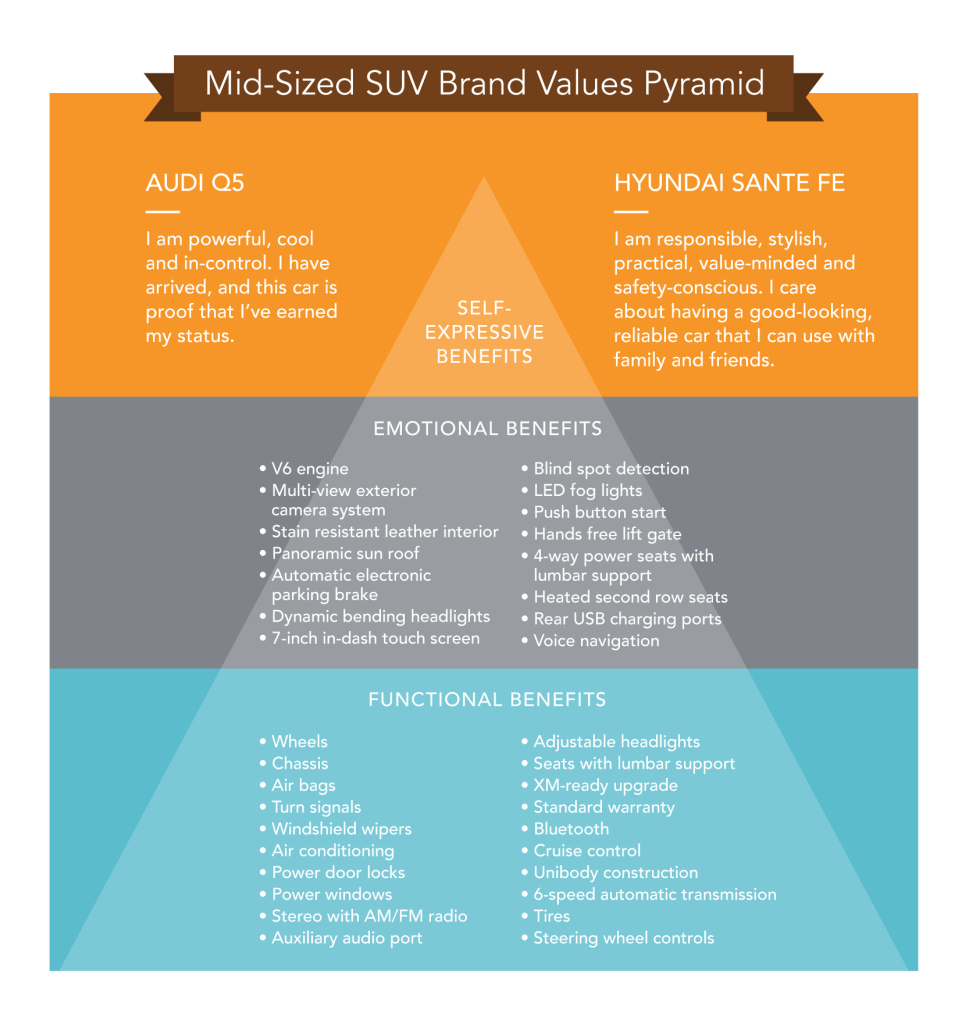The brand values pyramid: get to the top
by Deb Gabor In Marketing 101, professors taught us that customers make rational purchase decisions. However, as a student of branding and marketing over the past 25 or so years, I’ve learned that reason informs, but emotion persuades.
The practice of branding requires digging a lot deeper into your customers’ needs, wants, and desires and then trying to uncover the inner stories customers tell themselves.
Marketing 101 was a good start, but to really understand branding, we need to leave the business school and walk across campus to the psychology department.
Maslow Was a Marketer If you think back to Psychology 101 class in college, you probably remember studying Maslow’s hierarchy of needs. Maslow shaped his hierarchy like a pyramid, with the most basic human needs—food, water, shelter, air—at the base and loftier, more emotional needs at the top. The theory is that all humans must first solve for the lower levels of the pyramid before moving to the upper levels.
Once a person is no longer worried about finding food and water, he or she can move up to solve the problem of safety. Once that person figures out safety, he or she can move up to love, and so on.
Just as Maslow’s hierarchy explains human motivation, the brand values pyramid illustrates the idea that, when a person makes a decision to purchase or use a brand, they are motivated to achieve certain needs. After fulfilling one need, a person seeks to fulfill the next one, and so on.
As customers move up the pyramid, brands must meet more of their customers’ emotional needs, and as those emotional needs are met by more and more companies, the best brands must support customers’ process of becoming self-actualized.
Branding Lessons from My Garage Currently, I have two cars parked in my garage. I drive a sweet midsize Audi SUV, and my daughter drives a midsize Hyundai SUV.
Baseline Requirements The things that make both of these products midsize SUVs are what we call baseline requirements, which equate to the base of Maslow’s hierarchy.
In Maslow’s pyramid, those basic physiological needs are food, water, shelter, air, and so on.
In midsize SUVs, the baseline requirements are wheels, an engine, and a steering wheel, as well as seats, mirrors, windows, and the basic functional benefit of getting you from point A to point B.
The basic things that these two cars have in common with one another that make them function as midsize SUV’s are the baseline requirements for anything in the midsize SUV category.
All cars must meet these baseline requirements and deliver these functional benefits, or today’s market of SUV buyers will not take them seriously.
Emotional Benefits The next levels up in Maslow’s hierarchy are safety, belonging, and affiliation and esteem needs. These are the benefits that make you feel like you’re part of a group and protected.
In the brand values pyramid, these middle tiers describe how certain features make the consumer feel. In car talk, these are the options. In branding, we refer to them as emotional benefits. Emotional benefits can provide a competitive advantage, but they are not your brand.
The options packages in the middle of the pyramid for today’s cars are things such as Bluetooth, voice-activated navigation, heated seats, self-darkening mirrors, bi-xenon headlamps, and a variety of other cool things.
Not every model of car in a category offers those features, so they’re still somewhat differentiating and can command a premium purchase price. However, these features are easy for other brands to imitate, so they don’t define the brand and certainly aren’t sustainable long-term brand differentiators.
Like the functional benefits we discussed before, emotional benefits alone will never be enough to create and sustain a brand. As today’s options become tomorrow’s standard equipment, these emotional benefits aren’t enough to differentiate your brand.
Self-Expressive Benefits Self-expressive benefits—the stuff at the top of the brand values pyramid—enable customers to complete the statement, “When I eat/drink/drive/wear/use this brand, I am___.”
This is where brands become transcendent, symbolizing their customers’ self-concept and giving consumers a vehicle to express themselves.
When brands provide self-expressive benefits to their users, they can engender deep emotional connections. For example, consider the difference between the self-expressive benefits associated with Heineken beer, which may heighten a person’s self-concept of being a sophisticated, discerning, worldly person, with those of Budweiser.
Back to the two cars in my garage: the Hyundai and the Audi both meet the baseline requirements for midsize SUVs and provide some similar and compelling middle-of-the-pyramid features and emotional benefits. These two cars are so similar in their physical makeup, features, and benefits, that if you were to take the brand names away, they’d be virtually indistinguishable.
But everyone can agree that an Audi is an Audi, and a Hyundai is not an Audi. It’s a Hyundai.
Each of these two brands is unique and singular in what they let their owners say about themselves. For me, driving an Audi makes me feel powerful, cool, and in control. For my daughter, driving the Hyundai makes her feel responsible, stylish, practical, and safety conscious. Those feelings connect us to each of the two brands in very powerful ways, and elevate our concepts of ourselves and support us in telling a story to the rest of the world.
The most powerful brands are the ones that say something about their user. The key to successful branding is to make self-expressive benefits part of the brand value proposition to add richness and depth to the brand and the experience of owning and using the brand.
How to Discover Your Brand’s Self-Expressive Benefits There are three questions that every brand must be able to answer in order to understand how the brand values pyramid impacts their brand. These questions can be difficult to get to the bottom of, but once you understand them, they allow your brand’s strategy to flow naturally.
The three questions are:
- What does using your brand say about your customers?
- What is the singular thing your brand delivers that customers can’t get from anyone else?
- How do you make your customer a hero in their own story?
These questions may seem simple, but very few companies are able to answer them clearly. Those who can are usually the brands who win.
How to accurately answer these questions is beyond the scope of this blog post. In fact, there are three full chapters in my book, Branding is Sex, that focus exclusively on better understanding these three questions.
If you’re a brand struggling to deeply understand your customers, that’s the best place to start.




